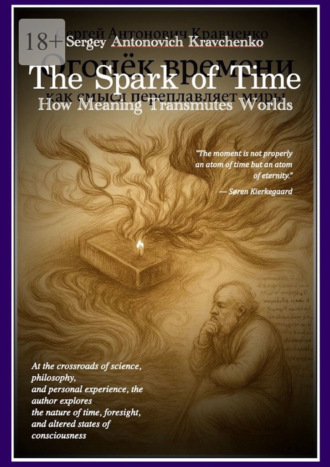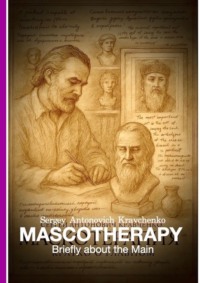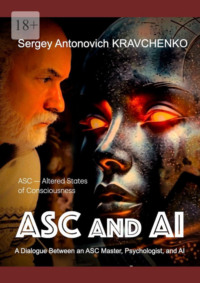
Полная версия
The Spark of Time. How Meaning Transmutes Worlds
Traditionally, psychologists said: «attention keeps us in the present.» I prefer a more precise formulation: the present is held by the intentional orientation of consciousness – the capacity to point «toward» a significant locus of the world. This notion, borrowed from phenomenology, helps explain why certain temporal objects (for example, the memory of a beloved person or the anticipation of danger) become centers around which the whole experience is organized. This intentionality also underlies the effectiveness of therapeutic methods: changing intentionality (reorienting attention, symbolic processing) alters the quality of the time in which a person lives.
Integration: The Boundary Between Dimensions Blurs
Bringing scientific and phenomenological observations together makes it clear: the boundary between «objective» and «subjective» time is conditional. Physics shows the locality and relativity of time; neuroscience shows that brain states reshape our metric of experience; psychology and epigenetics point to deep influential layers of memory and meaning. Taken together, they suggest that time is not a single background, but a multilayered fabric – something that can be studied and, under certain conditions, reshaped.
Transition to the Next Chapter – Experiences Beyond Time
If physics and cognitive science provide frameworks and tools, then a natural question arises: can this be experienced firsthand – purposefully or spontaneously? I do not limit myself to theory: in the next chapter I will describe my own experience of stepping beyond the familiar temporal scale, the methods of entering altered states of consciousness (autogenic training and other practices), clinical observations, and the checks that make foresight and altered states the subject of disciplined research.
Key Sources and References (for specialists and further reading):
– Wittmann, M. Subjective expansion of extended time-spans in experienced meditators (Frontiers in Psychology, 2014). (Frontiers, PubMed)
– Raichle, M. E. et al. A default mode of brain function (PNAS, 2001) and review works on the DMN. (PNAS, annualreviews.org)
– Studies on psilocybin and brain dynamics (e.g., increased repertoire of brain dynamical states under psilocybin; Carhart-Harris et al., various studies). (PubMed, PMC)
– AWARE studies on awareness during resuscitation (Parnia et al.). (PubMed)
– Dias, B. & Ressler, K. J. Parental olfactory experience influences behavior and neural structure in subsequent generations (implications for transgenerational epigenetic memory). (PubMed, PMC)
Chapter 3. Altered States of Consciousness and Transcending Time: The Author’s Experience
«If the doors of perception were cleansed, everything would appear to man as it is, infinite.»
– William Blake
Altered states of consciousness (ASC) for me are not a poetic metaphor, but a working laboratory. Within them, the habitual flow of time disintegrates and reorganizes anew; within them, the boundaries of the «I» dissolve, and past, present, and future may become interwoven in a single experience. I came to this gradually – through practice, observation, and thousands of hours of recording – and I wish to describe here not only the sensations themselves but also how they may be aligned with contemporary scientific perspectives.
My acquaintance with the subject began at the age of twenty through autogenic training. This method became my key to inner states: regular practice led to stable shifts in perception and to the possibility of entering what I later came to call the «conversion point.» Once, in a dream, numbers appeared to me – the sequence almost coincided with the winning combination of the «Sportloto» lottery. I awoke, hesitating whether to write them down – and this hesitation clouded my memory. Years later, a similar episode recurred with the «Stoloto» lottery: the image was there, the win was real, yet in both cases an error crept in – and I drew from this an important lesson: the mere fact of an experience does not automatically guarantee accuracy. Recording, protocols, and verification – these are what distinguish a random image from a reliable signal.
The Arctic became my «polar» laboratory of time. During the long nights, in the silence of snow and wind, I read and wrote extensively – Jung and Grof, books on the collective unconscious and on trance experiences. Stanislav Grof provided me with a map of states and practices that enabled me to comprehend experiences beyond the ordinary cognitive framework. Castaneda at the time seemed to me more of a literary reconstruction, but in the works of Grof and Jung I found both clinical and conceptual foundations for what I was observing myself. (Holotropic Bohemia, SCIRP)
The practices by which I entered ASC varied: autogenic training, prolonged sensory deprivation, periods of deliberate overexertion during my polar expeditions, meditations, and intentional role-playing techniques. Each path revealed the same: the temporal structure of experience reorganizes itself – the rhythms of consciousness alter the relation between «before» and «after,» and in place of linear flow arises a dense fabric of «present,» within which past and future coexist simultaneously in different qualities.
Modern neuroscience does not contradict these observations – it complements them. Reliable evidence exists that the brain’s «background» networks (especially the Default Mode Network) alter their activity in states of rest, meditation, and under the influence of psychedelics; these reorganizations correlate with changes in self-reflection and the perception of time. Raichle and colleagues described the DMN as a mode present during rest and associated with autopoietic processes of consciousness; when engaged in tasks or in other states, its configuration changes. (PNAS) Moreover, studies of meditative practice show that experienced practitioners regularly perceive a «stretching» of time and a greater density of the present. (PMC) Similar reorganizations are observed in research on the effects of psychedelics: they alter functional connectivity and dynamic complexity, accompanied by distinct transformations in temporal perception. (PNAS, PMC)
I do not elevate ASC to a sanctuary of truth: they are an instrument, and like any instrument, they require knowledge, technique, and safeguards. In clinical practice, I have repeatedly witnessed the reverse side: for some patients, spontaneous «falling out» into timelessness became a trauma. People lost their anchors, felt the shadow of death, saw catastrophic images – experiences that disrupted their life structures and led to depression or psychosis. These observations brought me to two important conclusions: (1) accompaniment and integration are indispensable; (2) safety techniques are necessary, providing the personality with support upon return to ordinary time.
Mask therapy became precisely such a protective «arsenal» for me. Under the guidance of its founder, G. M. Nazloyan, I studied and practiced mask-therapeutic work for many years – until his passing – and applied it as a stabilizing element in work with clients who had undergone deep ASC. In my experience, mask therapy is not merely a creative play but a method enabling symbolic consolidation of what has been lived through, restoring the boundaries of the «I» and giving the image a safe form of integration. (I studied the method under Nazloyan’s supervision and applied it in clinical practice.)
Moving to Moscow and meeting Alexander Petrovich Levich, initiator of the Institute for the Study of the Nature of Time, gave my work both scientific and organizational scope. At the Institute, and later in the International Center for Anticipation that we established, we undertook systematization: collecting diaries, formalizing protocols of entry into and exit from ASC, testing verification criteria of foreseeing, and applying expert systems and AI to analyze a large corpus of signals. Practice showed that the reliability of foreknowledge increases with the discipline of protocol: temporal markers, independent verification, expert consensus, and statistical checks reduce the share of erroneous interpretations.
Theoretically, I advanced a hypothesis I called the condensate of temporal crystallization (CTC): under certain conditions, consciousness and the semantic structure of experience attain such coherence that at the «conversion point» the image acquires an increased statistical correlation with a probable future. This is not alchemy or magic – it is a working model, testable through neurophysiology, semantic analysis, and event-base verification. CTC is an attempt to link the phenomenology of ASC with real markers (theta/alpha rhythms, changes in DMN organization, indicators of complexity and synchrony) and with methodology: protocols, blind testing, and AI support.
It is important to emphasize: I do not claim that ASC provide «truth» automatically. They provide the possibility of noticing signals and meanings that remain invisible outside of practice. Our task is to cultivate a reliable methodology – as an archaeologist cleans and documents a find before presenting it to the world.
Finally – a philosophical note. Those who study consciousness and time often dispute the limits of scientific explanation. I propose a practical compromise: to preserve skepticism and method, yet not close the door to phenomenology. Altered states provide access to experiences that cannot be reduced in advance; science supplies the tools for their documentation and analysis; psychotherapy offers ways of integrating and protecting the personality. In this triad – empiricism, theory, and clinical ethics – I see a path that can be pursued both cautiously and boldly.
Key scientific references underlying this chapter:
– Stanislav Grof – works on holotropic breathwork and the cartography of non-ordinary states of consciousness. (Holotropic Bohemia)
– C. G. Jung – the concept of synchronicity as meaningful correlation without explicit causal connection. (SCIRP)
– Raichle M. E. et al. – «A default mode of brain function» (description of the DMN). (PNAS)
– Wittmann M. – studies on the subjective expansion of time among meditative practitioners. (PMC)
– Contemporary reviews on psychedelics and the reorganization of functional connectivity (Carhart-Harris et al.). (PNAS, PMC)
Part II. Time in Science
Chapter 4. Classical Physics and the «Arrow of Time»
«The entropy of the universe tends to a maximum.»
– Rudolf Clausius
When I speak with people about time, the first resistance usually appears at the level of imagery: many still imagine time as a straight river, slowly carrying us from the past to the future. This Newtonian image – of «absolute, true, and mathematical time,» as Newton wrote – is convenient and simple. It gives us a scale for calculations, clocks, and calendars by which social life is structured. Yet reality turned out to be trickier, and already in the 19th—20th centuries we had to accept: time is not necessarily that simple.
The Arrow of Time – from Experience to Law
The idea of the «arrow of time» translates a scientific problem into an image. Arthur Eddington, as early as the beginning of the 20th century, proposed this metaphor to emphasize a simple thought: the world appears directed – we remember the past and anticipate the future; a glass that falls on the floor does not reassemble; cooks do not return a thick stew back into the pot. Why is that? The answer of classical physics came in the formula of thermodynamics: the second law, the growth of entropy – and, with it, Ludwig Boltzmann’s statistical picture, explaining irreversibility as a matter of probabilities.
It is important to pause here: the microscopic equations of mechanics are reversible – they can formally be run backward, and they remain valid. Yet the macroscopic picture – the one visible to humans in daily life – is consistently non-reversible. Here physics meets philosophy: the arrow of time can be explained statistically (an ordered set of microstates is rare; chaos is common), but the question remains why, under our specific conditions, the initial state so often turns out to be more ordered than what follows.
This statistical picture was challenged by Loschmidt and Poincaré: if the equations are reversible, why do we not observe reverse processes? Why do we not speak of return? The answer involves ideas about the initial conditions of the Universe and about scales of probability – a question that is not only mathematical, but cosmological. One way or another, in human experience the «arrow» is felt as fact – and its connection with entropy gives us the first, physical foundation for irreversibility.
Human Beings, Memory, and Direction – Where the «Arrow» Meets Life
For psychology and for my clinical observations, it is important that the physical arrow is closely linked to information: the growth of entropy resembles the loss of information about an initial order. We remember the past because structures are inscribed in it – traces of ordered states; the future, by contrast, is rich in possibilities but poor in determinacy. In this sense, memory acts as a local «retransmitter» of order: it preserves the sequence of events and thereby sustains the subjective directedness of time.
Yet human experience gives us other voices. In deep grief, the past pulls us back; in ecstatic creativity, the present expands into infinity – and it seems the temporal arrow is temporarily blunted. These phenomena do not contradict physics; they indicate that time has both objective and subjective «faces» – and where they meet arises a field for psychological and philosophical exploration.
Jung and Archetypal Time: Circles of Meaning
Here I take a step from physics toward psychology, but not toward unscientific mystification: Carl Gustav Jung introduces the concept of archetypes – fundamental universal structures of meaning, «primordial images,» that manifest in myths, dreams, and rituals. For Jung, time is not simply linear: archetypes operate «outside of time» and simultaneously influence past, present, and future, creating repeating motifs and cycles in the lives of individuals and collectives.
The Jungian perspective gives us another «arrow»: not the arrow of entropy, but the arrow of meaning. Where physics speaks of direction in terms of order changing, psychology shows that human history is full of «returns» – recurrent symbols, recurring dramas, not reducible to the law of probability. These repetitions are manifestations of the collective unconscious, and in therapy they often appear as «repeated plots» that must be recognized and worked through.
In my work with patients, archetypal time manifests vividly: symbolic repetitions, uncontrolled returns of old plots, «as-if» sensations when the past resurfaces and animates the present. This does not contradict physics – it is a different level of describing reality, and both levels are important.
Bringing Together the Facets: Entropy, Information, and Meaning
If we try to connect the Newtonian—thermodynamic picture with the Jungian one, we discover an intriguing possibility. Entropy is a measure of uncertainty; meaning is a local reduction of uncertainty, an act of ordering information. When collective archetypes activate, they condense meaning, create stable forms of behavior and perception. In conditions where meaning is locally strong, subjective time takes on a different density: memory becomes richer, anticipation becomes significant. It is precisely at this «border» – where statistics meet semantics – that I later place the concept of the conversion point and the working hypothesis of the TCC (Temporal Crystallization Condensate).
The Practical and Ethical Meaning of the «Arrow»
Understanding the arrow of time is important not only for physicists and philosophers – it shapes practice: therapeutic approaches, organizational decisions, risk management. If time at the macro level tends toward greater uncertainty (entropy), then individuals and communities need ways to locally sustain order – externally (structure, rules) and internally (symbols, rituals, mask therapy). In my experience, restoring personal boundaries and integrating lived altered states of consciousness proceeds through work with symbols and meaning – thus a person acquires tools for navigating a world where the arrow of time remains real, but its effects can be softened and guided.
Conclusion and Transition
The classical picture of the «arrow of time» gives us a foundation – thermodynamic and statistical – for understanding irreversibility. The Jungian perspective expands this picture by introducing the dimension of meaning and archetypes, which create cycles and repetitions in human life. Together they suggest: time is multilayered, and to grasp it, we must learn to shift between levels of description.
In the next chapter, we will turn to the revolution of the 20th century: to Einstein and the idea of space-time, where the «locality» and «relativity» of time take concrete mathematical form. For our theme, this is an important step: it shows how physics pushes the boundaries of the possible, while we – practitioners and philosophers – can take up the tools and listen to the new questions posed by the very fabric of reality.
Chapter 5. Einstein, Relativity, and Space-Time
«The distinction between past, present and future is only a stubbornly persistent illusion.»
– Albert Einstein
The beginning of the 20th century changed my understanding of what «time» is – as radically as fire changes the face of metal. Albert Einstein showed that time can no longer be regarded as a single, universal background. Together with space, it forms a unified four-dimensional fabric – space-time – and the properties of this fabric depend on motion and mass. This is not a poetic metaphor but mathematics with real consequences: clocks standing side by side can measure different «times.»
I value two of Einstein’s aphoristic formulations. The first – often quoted in its classical translation:
«Time is what clocks measure.»
A simple phrase, but to my mind, extremely important: it reminds us that «time» in the physical sense is defined by the behavior of concrete systems (clocks). The second, more reflective thought – about the nature of space and time as forms of our thinking – forces us to recall that many notions we once believed absolute may turn out to be conditional in another context. Finally, his famous remark on past, present, and future – «for us physicists who believe, the distinction between past, present and future is only a stubborn illusion» – provokes the philosophical questions we will not avoid here.
What Does «Relativity» Mean in Practice
In Einstein’s special theory of relativity, the central idea is: the laws of nature are the same in all inertial systems, and the speed of light is constant. From this follows the destruction of absolute simultaneity: two events that are simultaneous for one observer may be non-simultaneous for another moving relative to the first. The impression of «one time for all» disappears: time becomes local, «proper» for each worldline.
In the general theory of relativity, space-time becomes dynamic: mass and energy curve the fabric, and this curvature affects the paths along which objects and light travel, and therefore the flow of local clocks. In practice this is no abstraction: experiments with precise atomic clocks confirmed the slowing of time both at high speeds and near massive bodies; the global GPS system works only because engineers account for corrections from both special and general relativity.
Another clear image is that of «proper time»: the «time» recorded by a specific clock (or observer) along its path in space-time. In the language of physics, each worldline has its own metric – and it may differ from that of another, even if they started out side by side.
Paradoxes and Intuitive Shocks
Particularly famous is the thought experiment – the «twin paradox» – in which one twin travels away at high speed and returns «younger» than the other. The resolution lies in the asymmetry of events (acceleration, change of inertial system) and in the fact that the proper model requires accounting not only for speed but also for the geometry of the trajectory in space-time. I often return to this example in conversations: it vividly demonstrates how different our intuitive, «human» moment of time is from physical proper time.
What Does This Mean for Our Understanding of Time as a Phenomenon?
For me as a researcher of consciousness and practitioner of altered states of consciousness (ASC), several important conclusions follow.
– Locality and multiplicity of «times.» Relativity introduces the idea that «time» is not a single property of the universe but a multitude of local parameters, depending on trajectories and conditions. This resonates with my distinction between measurable and unmeasurable time: physics shows that even the «measurable» is not singular.
– The right to a valid «order.» The notion of a single, unambiguous order of events dissolves – and this frees us methodologically: experiences in which the order of «past—present—future» shifts no longer automatically appear paradoxical. They fit into the broader framework of local temporal scales.
– The meeting point of science and phenomenology. If in physics «proper time» is the invariant metric along a trajectory, then for a subject there is a personal sense of time, also «invariant» for them. Here a dialogue is possible: biological rhythms, neurophysiological markers, and psychic states – all can be viewed as the subject’s «local clocks.» The TCC hypothesis, in which semantic and neurophysiological coherence create a local «crystallization» of time, can be read here as a proposal that under certain conditions consciousness may synchronize its «clocks» with informationally meaningful patterns of reality, thereby increasing correlation with event probabilities.
– Rethinking causality. Relativity does not abolish causality but complicates its form: the «dependence of times» forces us to take more care with concepts of one-way causality and event order. This resonates with the phenomena of synchronicity and foreknowledge – where the connection between meaning and event may not be linear.
Ethical and Practical Consequences
For psychotherapy practice and work with ASC, this has several consequences. First, the understanding of time’s locality strengthens my insistence on precise recording: temporal markers, context, the subject’s state – all are important, because the subject’s «clocks» and the «clocks» of external verification may run differently. Second, relativity suggests caution when interpreting «visions» and images: coincidence in content does not always mean coincidence on the same temporal scale. Finally, the theoretical recognition of multiple times provides an ethical basis for respecting subjective experiences; they cease to be «errors of perception» and become objects of study.
The End of One Fabric – The Beginning of the Next
Einstein’s revolution opened the door to a world where space and time ceased to be static stages for action. They became a weaving that reacts and responds to mass and energy. For me, this is not only a physical truth – it is an invitation to think of time as a dynamic resource, as a layer that can locally condense and crystallize, like a crystal forming a pattern in a flow.
From Einstein’s space-time begins the path to the ideas I explore further: quantum phenomena, time crystals, and – at the other end of the spectrum – the phenomena of consciousness, where time ceases to be only a dimension and becomes a medium of meaning.
In the next chapter, we will plunge into quantum physics and quantum entanglement: into a realm where the notion of time is again put to the test, and where surprisingly fruitful analogies arise with what I have observed in altered states of consciousness.



